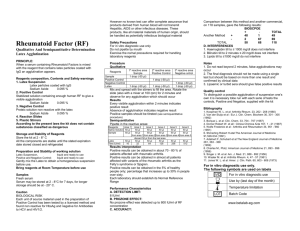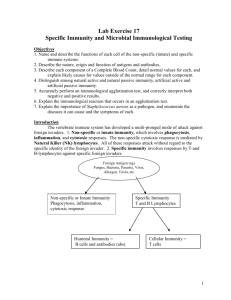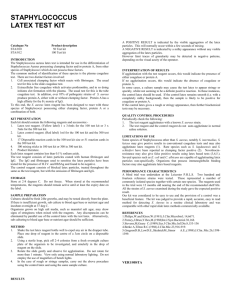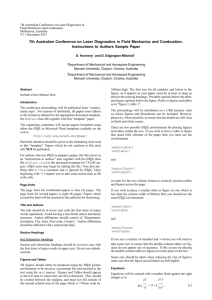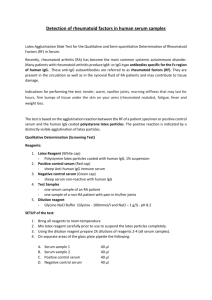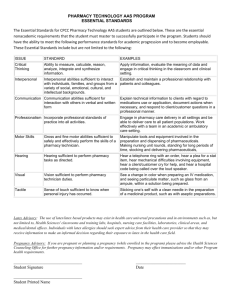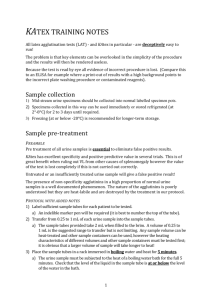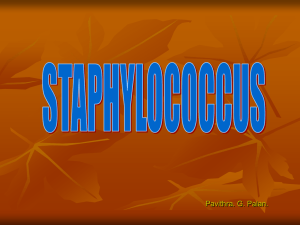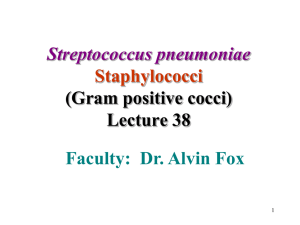Agglutination lab handout
advertisement
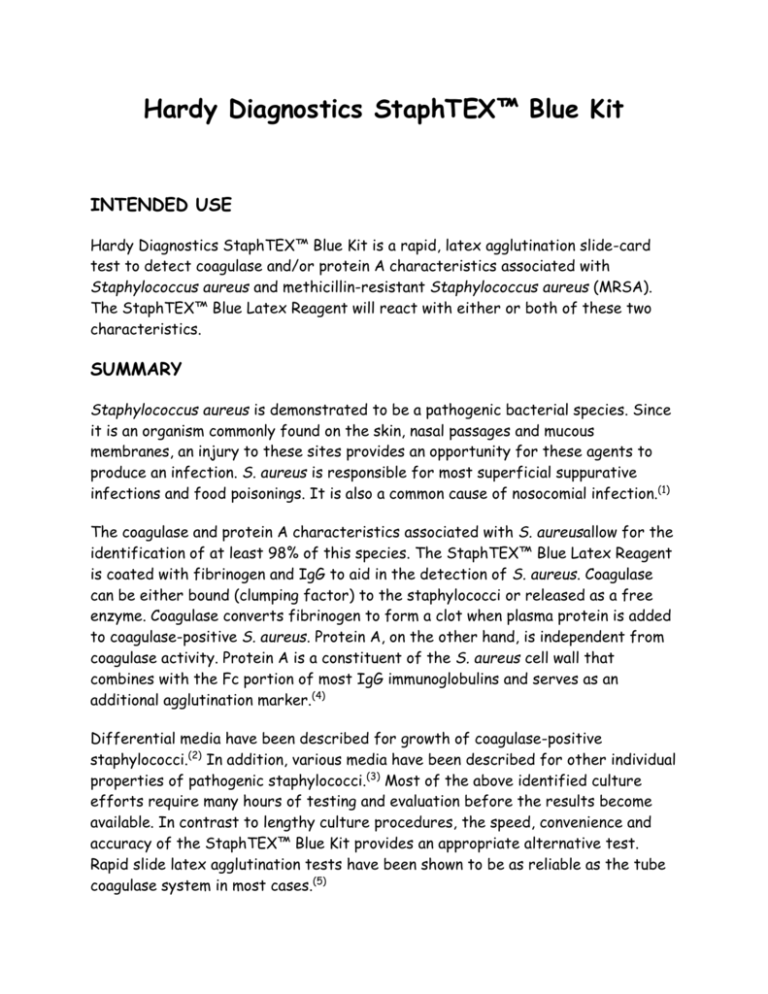
Hardy Diagnostics StaphTEX™ Blue Kit INTENDED USE Hardy Diagnostics StaphTEX™ Blue Kit is a rapid, latex agglutination slide-card test to detect coagulase and/or protein A characteristics associated with Staphylococcus aureus and methicillin-resistant Staphylococcus aureus (MRSA). The StaphTEX™ Blue Latex Reagent will react with either or both of these two characteristics. SUMMARY Staphylococcus aureus is demonstrated to be a pathogenic bacterial species. Since it is an organism commonly found on the skin, nasal passages and mucous membranes, an injury to these sites provides an opportunity for these agents to produce an infection. S. aureus is responsible for most superficial suppurative infections and food poisonings. It is also a common cause of nosocomial infection.(1) The coagulase and protein A characteristics associated with S. aureusallow for the identification of at least 98% of this species. The StaphTEX™ Blue Latex Reagent is coated with fibrinogen and IgG to aid in the detection of S. aureus. Coagulase can be either bound (clumping factor) to the staphylococci or released as a free enzyme. Coagulase converts fibrinogen to form a clot when plasma protein is added to coagulase-positive S. aureus. Protein A, on the other hand, is independent from coagulase activity. Protein A is a constituent of the S. aureus cell wall that combines with the Fc portion of most IgG immunoglobulins and serves as an additional agglutination marker.(4) Differential media have been described for growth of coagulase-positive staphylococci.(2) In addition, various media have been described for other individual properties of pathogenic staphylococci.(3) Most of the above identified culture efforts require many hours of testing and evaluation before the results become available. In contrast to lengthy culture procedures, the speed, convenience and accuracy of the StaphTEX™ Blue Kit provides an appropriate alternative test. Rapid slide latex agglutination tests have been shown to be as reliable as the tube coagulase system in most cases.(5) The blue-latex particles used in the StaphTEX™ Blue Latex Reagent are sensitized with specific concentrations of plasma proteins. When coagulase and/or protein A is provided by the culture specimen at detectable levels, they will interact with the sensitized particles to produce visible agglutination/clumping, indicating a positive test for S. aureus. MATERIALS SUPPLIED 1. StaphTEX™ Blue Latex Reagent: Blue-latex particles coated with IgG and human fibrinogen. The latex particles are suspended in a buffer containing 0.098% sodium azide as a preservative. 2. StaphTEX™ Blue Positive Control Reagent: A formulation of non-viable S. aureus in a buffer containing 0.1% sodium azide as a preservative. 3. StaphTEX™ Blue Negative Control Reagent: A formulation of non-viable, coagulase-negative Staphylococcus spp. in a buffer containing 0.1% sodium azide as a preservative. 4. Wooden sticks* 5. Disposable, white slide-cards with white reaction circles* PRECAUTIONS 1. For in vitro diagnostic use only. Do not dilute the StaphTEX™ Blue Latex or StaphTEX™ Blue Control Reagents or interchange with other StaphTEX™ Blue Kit lot numbers. Proper handling and disposal of the used slide-card(s) and other items that come into contact with culture organisms must be employed. Place used slidecard(s) and other disposable items in a container with laboratory disinfectant. The container should be autoclaved. 2. Reagents contain sodium azide. Sodium azide can react explosively with copper or lead if allowed to accumulate in large concentrations. Although the amount of sodium azide is minimal, large amounts of water should be used when flushing used reagents down the sink. 3. StaphTEX™ Blue Latex Reagents, StaphTEX™ Blue Positive Control Reagent and StaphTEX™ Blue Negative Control Reagent should be handled using the same safety precautions employed when handling any potentially infectious material. Note: Only personnel who have been properly trained in the hazards of working with microbial systems and those who are competent in microbiological techniques should perform this test. SPECIMEN COLLECTION AND PREPARATION FOR ANALYSIS It is recommended that an overnight (18-24 hour) culture of a primary plated clinical specimen, using Sheep Blood Agar or Nutrient Agar, be used to provide a fresh, sufficient sized (2mm) colony. A secondary subculture to isolate the species of a mixed culture will sometimes be necessary before testing. However, repeated subculturing of staphylococci has been shown to allow these organisms to manifest different characteristics from the original isolate.(6) For specific procedures regarding specimen collection and preparation refer to the listed references. In general, the colony should be gram stained to confirm the morphology and gram-positive characteristics of the organism being tested.(3,7) PROCEDURE The Latex Reagent should be at room temperature prior to use. Remove from the refrigerator at least 10 minutes prior to use. Do not allow the tip of the latex vial to touch a specimen. 1. Perform the quality control steps as outlined before testing fresh colony specimens. 2. Resuspend the Latex Reagent by several inversions of the vial. Hold the latex vial in a vertical position just over a white reaction circle on the slide-card. Squeeze the vial to deliver a drop of resuspended Latex Reagent into the reaction circle. Place a drop for each specimen to be tested in separate reaction circles. 3. Use a fresh stick for each specimen. While holding the stick perpendicular to the agar surface, touch one, 2mm fresh colony with the flat end of the stick. 4. Thoroughly mix and blend the organisms into the Latex Reagent by lightly rubbing the surface of the slide-card with the stick to the inside limits of the reaction circle. Note: Avoid damaging the slide-card surface with vigorous rubbing. 5. Discard the stick into disinfectant. 6. For 20 seconds, gently hand-rock the slide-card to agitate the combination. Do not allow the combinations to spill over into adjacent reaction circle. 7. Clumping of the Latex Reagent should be instantaneous with most S. aureus strains. Record the results according to the interpretation section below. Do not read results after 20 seconds from the initial blending. 8. Follow appropriate procedures for disposal of infectious material. INTERPRETATION OF RESULTS A positive test has occurred when agglutination and/or visible clumping of the Latex Reagent/specimen combination is observed within 20 seconds. When obvious latex agglutination is observed within this period, coagulase and/or protein A is present and the specimen is presumed to be S. aureus. In a positive reaction, a significantly rapid and strong clumping (within 20 seconds) with the Latex Reagent is observed. A negative test result has occurred when no agglutination/clumping is observed by the Latex Reagent within the 20 second period. Ordinarily, a homogeneous background should be observed for most negative results. A negative result indicates the absence of coagulase and/or protein A for that specimen. Occasionally, a trace of granularity by the latex particles may be observed with a coagulase-negative specimen. LIMITATIONS 1. Rough, stringy and non-interpretable results may occur when specimens have been grown on high salt-containing media and the culture is older than 48 hours. In these instances, the concentration of coagulase and/or protein A may be reduced and consequently produce very weak agglutination patterns. 2. Stock cultures should be subcultured onto Sheep Blood Agar overnight before use in the test. 3. Only 18-24 hour old fresh colonies should be used with the test. The colony should be Gram stained to confirm the morphology and gram-positive characteristics of S. aureus. Only catalase-positive colonies should be tested with StaphTEX™ Blue. 4. If the suspension of organism used is not heavy enough, the reaction may be weak and slow in agglutinating, and may lead to erroneous results. 5. Although other coagulase-positive staphylococci such as S. hyicus and S. intermedius can agglutinate the Latex Reagent, they are rarely associated with human infection.(6) 6. Due to a drying effect, false-positive reactions may occur if reaction times longer than specified are used. 7. Some streptococci, Escherichia coli, C. albicans and possibly other organisms that possess immunoglobulin binding factors may also agglutinate Latex Reagents non-specifically.(10) Therefore, test only gram-positive catalase-positive organisms with the StaphTEX™ Blue Kit. 8. Some rare species of clumping factor-positive S. lugdunensis and S. schleiferi may yield positive or weakly positive latex agglutination results. Novobiocin resistant strains may also agglutinate with the test reagent and yield a falsepositive result. If necessary, further identification using biochemical test procedures should be performed. Confirmation of S. lugdunensis may be accomplished through use of the tube coagulate test (negative), Cat. no. Z202; PYR test (positive), Cat. no. Z75; or Rapid Ornithine test (positive), Cat. no. K279. Hardy Diagnostics' StaphTEX™ Blue Kit (Cat. no. ST50). Showing positive (left circle) and negative (right circle) agglutination for the StaphTEX™ Blue Kit (Cat. no. ST50). REFERENCES 1. Kloos, W.E. and P.B. Smith. Staphylococci. 1980. Manual of Clinical Microbiology, 3rd ed. E.H. Lennette, A. Balows, W.J. Hausler, Jr. and J.P. Truant, ed. ASM, Washington, D.C. 2. Finegold, S.M. and E.E. Sweeney. 1961. New Selective and Differential Medium for Coagulase-Positive Staphylococci Allowing Rapid Growth and Stain Differentiation. J. Bacteriol.; 81:636-641. 3. Kloos, W.E. and K.H. Schleifer. 1975. Simplified Scheme for Routine Identification of Human Staphylococcus Species. J. Clin. Microbiol.; 1:82-88. 4. Forsgren, A. and J. Sjoquist. 1967. "Protein A" From Staphylococcus aureus. Reaction with Rabbit Gamma-Globulin. J. Immunol.; 99:19-24. 5. Aldridge, K.E., C. Kogos, C.V. Sanders and R.L. Marier. 1984. Comparison of Rapid Identification Assays for Staphylococcus aureus. J. Clin. Microbiol.; 19:703-704. 6. Kloos, W.E. and T.L. Bannerman. 1994. Update on Clinical Significance of CoagulaseNegative Staphylococci. Clin. Microbiol.; 7:117-140. 7. Hajek, V. 1976. Staphylococcus intermedius, A New Species Isolated From Animals. Int. J. Syst. Bacteriol.; 26:401-408. 8. Roberson, J.R., L.A. Fox, D.D. Hancock and T.E. Bessor. 1992. Evaluation of Methods for Differentiation of Coagulase-Positive Staphylococci. J. Clin. Microbiol.; 30:3217-3219. 9. Zanella, M., A. Rashasa, V. Baselski and B. Madison. 1994. Evaluation of a New Latex Agglutination Kit for Identification of Staphylococcus aureus. ASM, Abstracts No. C-129, p. 513: ASM 94th General Meeting, Las Vegas, NV. 10. Myhre, E.B. and Kuusela, P. 1983. Inf. Imm.; 40:29-34. 11. Carr, A. and Davies, S. 2007. Comparison of Two Rapid Agglutination Test for the Detection of Staphylococcus aureus ASM 107th General Meeting, Toronto, Ontario, Canada.

